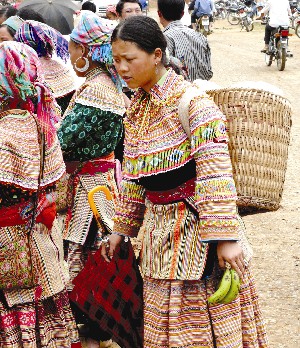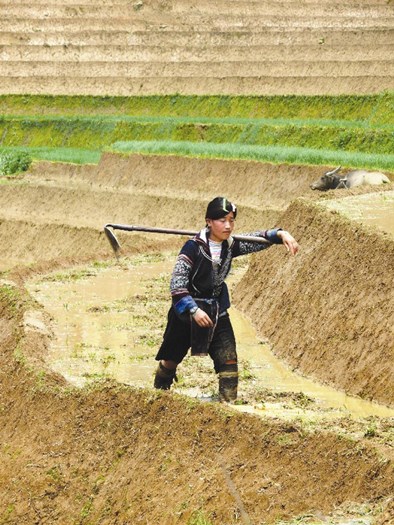SAPA, VIETNAM – The gentle swaying of the Victoria Express rail car awakens me in the early hours of the morning – when the darkness of night begins to give way to the beginning of day. Billowing black mountains silhouetted against a moonlit sky reveal themselves when I peer through the car’s picture window as the train cuts through Vietnam’s dense jungle en route to this northern outpost, renowned for its dramatic mountain landscape and tribal hill people. It’s not yet 5 a.m. but already men riding water buffalo head for terraced rice paddies for a long day’s work and women wash clothes in the dimness of the morning.
A knock at the cabin door tells me its time to gather my belongings in preparation for our arrival at Lao Cai, the city closest to remote Sapa and the capital of the northern province, also known as Lao Cai, which is home to 24 of the country’s 54 hill tribes.
As I emerge from the station, a scene of chaos greets me. Taxi drivers, offering transport in cars, trucks or on motor scooters, vie for business by shouting at potential customers, many of them backpackers who ask where they can find the local bus to take them to Sapa, 33-kilometres away. Through the confusion, I see my name printed on a piece of cardboard, which is being held aloft by a man who seems oblivious to the chaos. I approach the man with the brush cut and introduce myself.


Above: Women dress in traditional outfits at the local market and in the terraced rice fields.
“Greetings, my name is Tuyen Khac Nguyen and I will be your guide in Sapa,” replies the man from the Victoria Resort and Spa, my home base during a two-day stay in Sapa, a word which means “land of sand.”
We pile my belongings into the guide’s Korean-made 4x4 and he suggests I call him “Khac, because it is much easier for foreigners to say,” before we drive out of Lao Cai, a border town that sits directly across the Red River from China.
The winding, twisting mountain road that connects Sapa and Lao Cai takes a steady hand on the wheel and nerves of steel to navigate. But Khac seems to know every bump and turn and casually manoeuvers his way around obstacles, like slow-moving scooters, broken down trucks and stray water buffalo with the ease of a man who has made this drive many times before.
Not long after leaving Lao Cai, the dramatic terraced rice fields the hill people have carved into the steep mountain slopes come into view. They are simply breathtaking.
A few minutes later, I get my first sighting of a hill tribe woman, bedecked in full native costume with a baby strapped to her back and carrying yarn made from hemp which she weaves into fabric to make her family’s clothes. Khac explains the woman wearing a black scarf around her head belongs to the Black Hmong, one of six Hmong tribes that dominate this lush agriculture area.
“There are Black Hmong, Red Hmong, White Hmong, Chinese Hmong, Green Hmong, and my favourite, the Flower Hmong – they wear the most colourful costumes,” Khac tells me.
“The Hmong women bring up the children, work in the rice field, do all the cooking and house chores and make all their own clothes. If the family has a horse, then the Hmong man rides the horse and the woman always walks behind with her children. It is the way of the Hmong people. The Hmong man only gets drunk on rice wine,” laughs Khac.
As she passes, I see the woman’s weathered face is marked with deep lines, her dark skin is as rough as leather and she walks stooped over, suggesting she is old.
“Not old,” says Khac. “Maybe 40. Working stooped over in the wet rice fields and heat all day makes them look much older – they all have back problems.
“Most Hmong women get married by the time they are 14 or 15 – they have their first child a year or so later and they usually have between five to eight children – the family needs a lot of help growing the rice and corn they live on,” Khac tells me.
The Hmong women and their children carry on the tradition of wearing the heavy native costumes of their ancestors, complete with leggings that are worn at all times of the year, including Vietnam’s stifling summer months. Hmong men, on the other hand, wear western-style clothes.
My Swiss-style resort is perched atop a hill overlooking charming Sapa, whose town centre is dominated by a Catholic church built during France’s Indochina occupation. It’s still quite early so the streets of this town, that sits 1,600 metres above sea level, are relatively quiet. The resort is the only modern building in Sapa.
Khac suggests I get some rest before our first tour of the area – “a 2.5 kilometre valley walk through terraced rice fields to a Hmong village.”
The prospect of going to a Hmong village and meeting Vietnam’s native people, whose ancestors came from China about 5,000 years ago, has me waiting in the lobby a half hour before Khac’s return. Khac, now accompanied by another man who acts as his copilot, drives to a high spot on a road just outside Sapa where a group of Hmong women greet us.
No sooner do we begin our trek when three young Hmong women approach us, pushing handmade crafts – silver jewelry, colourful bags, brightly decorated wall hangings and their traditional clothing – at us.
“You buy from me?” says one. Then another adds: “You buy from me?” Soon, they’re all asking: “You buy from me?” We are surprised by their excellent knowledge of English.
“We learn English from tourists,” says one of the women – an 18-year-old who is pregnant with her second child.
As we walk, the women tell us of their rituals and customs and dispense with the hard sell after we agree to buy something from them at the end of the walk.
One of the women – her name sounds like Lily – says there are over one million Hmong people living in Lao Cai province and her Red Hmong tribe shares the village with their rivals, the Black Hmong.
Khac later tells me the Red and Black Hmong were fierce opponents at one time but were ordered by Vietnam’s communist leaders to get along.
“They (rival Hmong tribes) never marry each other – they barely speak,” says Khac as we come upon a group of Black Hmong women standing knee-deep in a muddy rice terrace, churning up the soil with their bare feet.
It takes two years of hard digging to create one of the rice terraces, which dominate every inch of the region. There are no modern conveniences here and the water buffalo, covered in mud to protect them from insects and the blistering sun, serve as the workhorse of the rice paddies.
With the three women still in tow, we finally reach the village, where the modest homes are made of mud and straw and feature one large room divided into sections where two or three families live.
Each of the delightful women displays a gold tooth when they smile – a symbol of wealth within their community, according to our guide. Lily has two gold teeth.
“The last hill tribe was discovered in 1996 by a Vietnamese army officer near the Cambodia border,” says Khac. “There were only 120 Rucs when they were first found running around the jungle naked, but there are over 500 today”.
Besides their headdress, another way you can tell the tribes apart is that some, like the Red Hmong women, shave their foreheads back several inches because, they say, it brings them luck.
The rich, sandy soil around Sapa supplies the Hmong people with the perfect land on which to grow their rice and corn, the main staples of their diet.
Each day, in the communities surrounding Sapa, markets are held and the Hmong people show up selling crafts and vegetables. One of the most amazing markets is held each Saturday in remote Can Cau, a three-hour drive from Sapa. Can Cau is reached after navigating a treacherous stretch of highway that winds through some of the most jaw-dropping landscape on Earth.
After finishing our valley trek, the three Hmong women remind us of our promise to buy something. We fork over $20 and get more than we can carry – wall hangings, silver jewelry, a couple of handbags and other trinkets.
“You come back again,” says Lily. “We never forget you.”
As we climb into Khac’s car, I hear Lily say to a new customer, “You buy from me?”
Tour East Holidays offers fully escorted trips to Vietnam for as little as $3,900, including airfare. Go to www.toureast.com for more details.